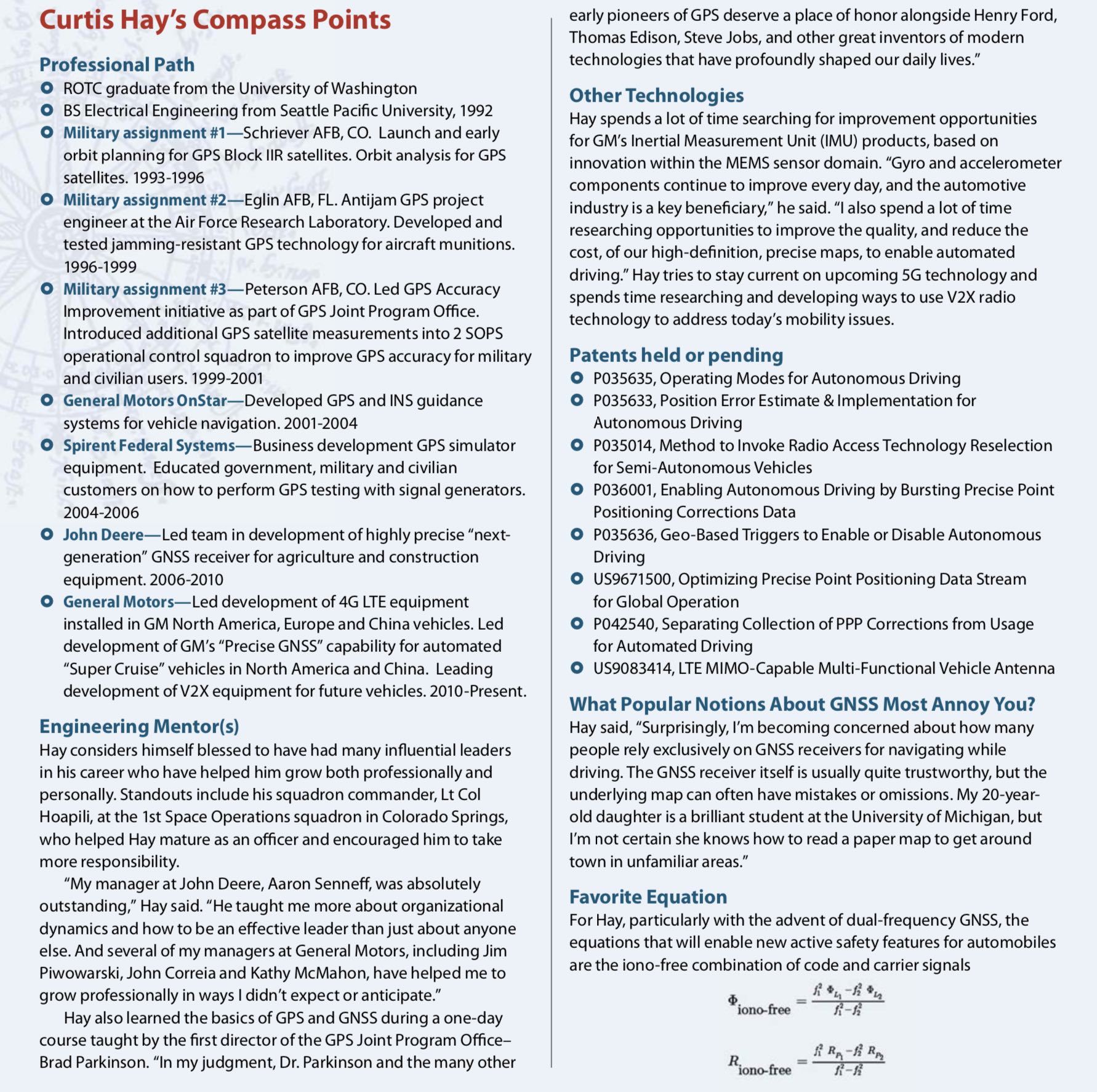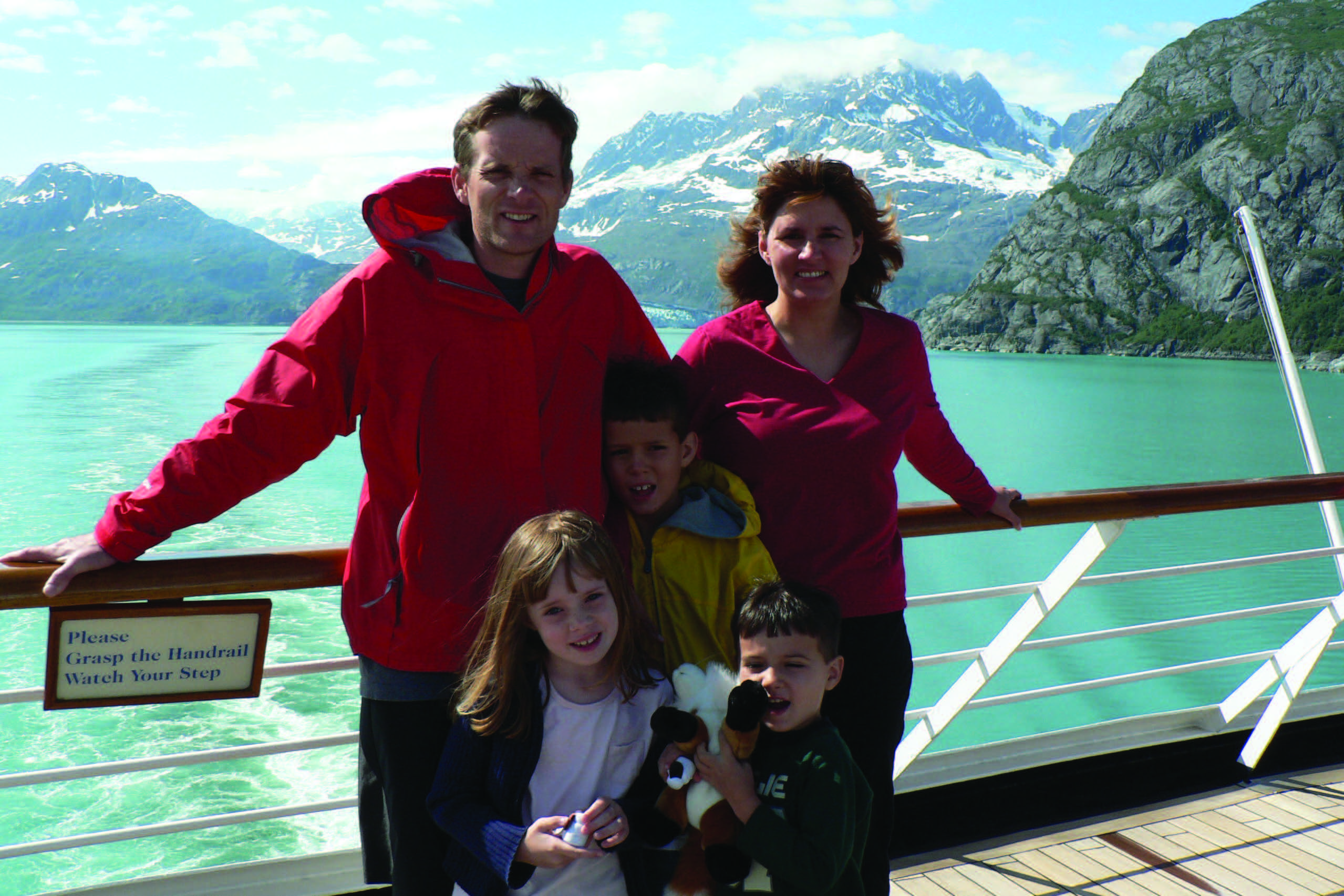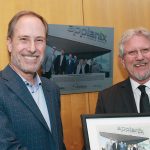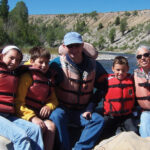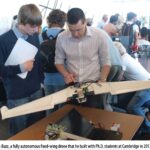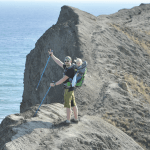Curtis Hay is a Technical Fellow at General Motors, where he develops precise GNSS and map technology for safe and reliable autonomous and semi-autonomous vehicles. He has appeared on many international stages, but while he very much enjoys traveling and meeting people in faraway lands, both for work and for pleasure, he knows where home is.
Many of our readers will know Curtis Hay’s face and will have heard him speak. He led the team responsible for launching General Motor’s 4G LTE connectivity in North America, Europe and China. Hay served as an officer in the U.S. Air Force for eight years where he developed GPS technology for precision weapons, performed satellite launch planning and managed the GPS Accuracy Improvement Initiative. He has worked for the Intel Corporation in Ireland, for Spirent, and for John Deere, where he developed precision GPS equipment to automate farm and construction vehicles.
“I grew up in the western U.S.,” he told Inside GNSS. “I was born in California, and during my youth I spent time living with my father in California and Idaho, and with my mother in Utah and Idaho. And, along with my older brother, I spent summers with my grandparents in Wyoming.” Hay belongs to all of these places, and they belong to him. “My brothers and I were raised with a sense of adventure and a deep appreciation for mountain landscapes,” he said.
Near a place called Sun Valley, Borah Peak stands as the highest mountain in the state of Idaho, rising to just under 13,000 feet of elevation. “When I was in fifth grade I climbed Borah Peak with my dad and my older brother,” Hay said. “It is a long trek with many steep and exposed sections of the trail. I was so proud when we reached the summit.”
Hay said that climb taught him about the importance of perseverance in achieving a personal goal. That understanding has seen him through many a challenge, allowing him to climb and climb. He has scaled 32 of the 14,000-foot peaks in Colorado, and he has ascended with alacrity the GNSS career ladder. Wherever he’s been and whatever he’s done, the great western American lands have remained with him, a kind of sacred backdrop to his life.
“My family enjoyed the great outdoors,” he said. “Exploring was an important part of my childhood. I learned to catch trout in the Bighorn Mountains in northern Wyoming with my uncle and great-grandmother, and did a lot of camping, skiing and backpacking in the Sawtooth Mountains of central Idaho with my immediate family.
“Some of my earliest memories include hiking in the Rockies and swimming in natural hot springs across the west.”
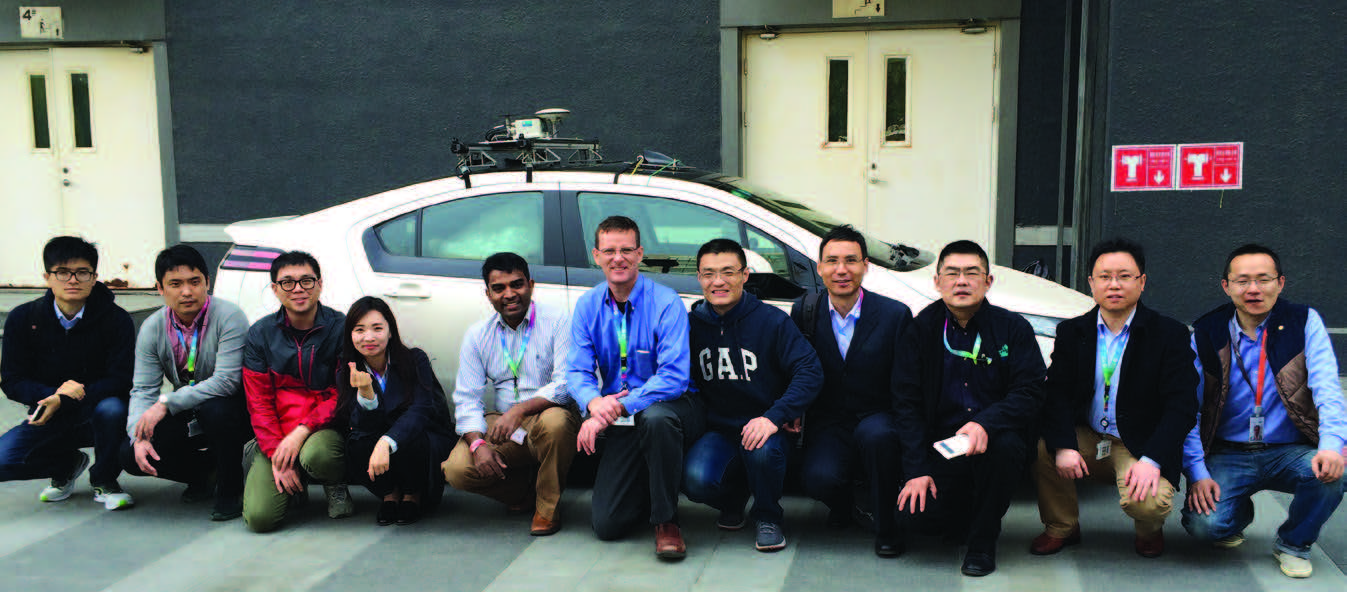
Influencers
Fantastic scenery there was aplenty during Hay’s childhood. But there was also, and readers will have noticed this already, a strong sense of family. He rarely talks about his childhood experiences without mentioning the family members who were there with him.
Hay’s parents divorced when he was very young, and he spent much time with his father and step-mother. “My father has been a major source of inspiration for me,” he said. “I still love the great outdoors because of the time we spent together camping and hiking throughout my childhood.”
Curtis Hay’s father, Charles Hay, grew up in rural Idaho before attending college at Stanford, in California. After graduation, he moved back to Idaho and put himself through law school. He was a lawyer for about 14 years before becoming a county judge, about the time when young Curtis was starting his own college career.
“My father also inspired me with his strong religious faith,” Hay said. “We were active in our church and my dad’s faith in God was a great example of how to live by Christian principles in everyday life. I believe in the importance of treating others how I would want to be treated myself. This is one of many lessons I learned from my father. I also admired his ability to leave the law firm behind after a day’s work, switching gears between professional and personal life to spend evenings with his family.”
After Hay’s parents divorced, his father met Hay’s step-mother, Roberta, while attending law school. They have been married for 45 years. Hay said his step-mother was another important figure in his life. “She was raised in Idaho and was an elementary school teacher. She taught me the value of hard work and taking responsibility for my own actions and decisions.”
Another key figure in Hay’s early life was his great-grandmother, Greta Daniels, with whom he spent his summers in Wyoming. “She was a wonderful, caring woman who always wanted the best for me,” he recalled. “She was a talented painter and was very active in her community. She died of cancer when I was twelve and I still miss her profoundly.”
While he lived with his father and step-mother for most of his youth, Hay always remained close to his mother, now Virginia Lee, usually spending summers with her and his step-dad J.R. It was she who gave him an electronics hobby kit for a birthday present when he was in junior high school. “I really enjoyed connecting the simple circuits, the wires, batteries, resistors, capacitors and other components, to make radios, strobe lights, and similar fun inventions,” he said. Young Curtis was starting to look like a budding engineer.
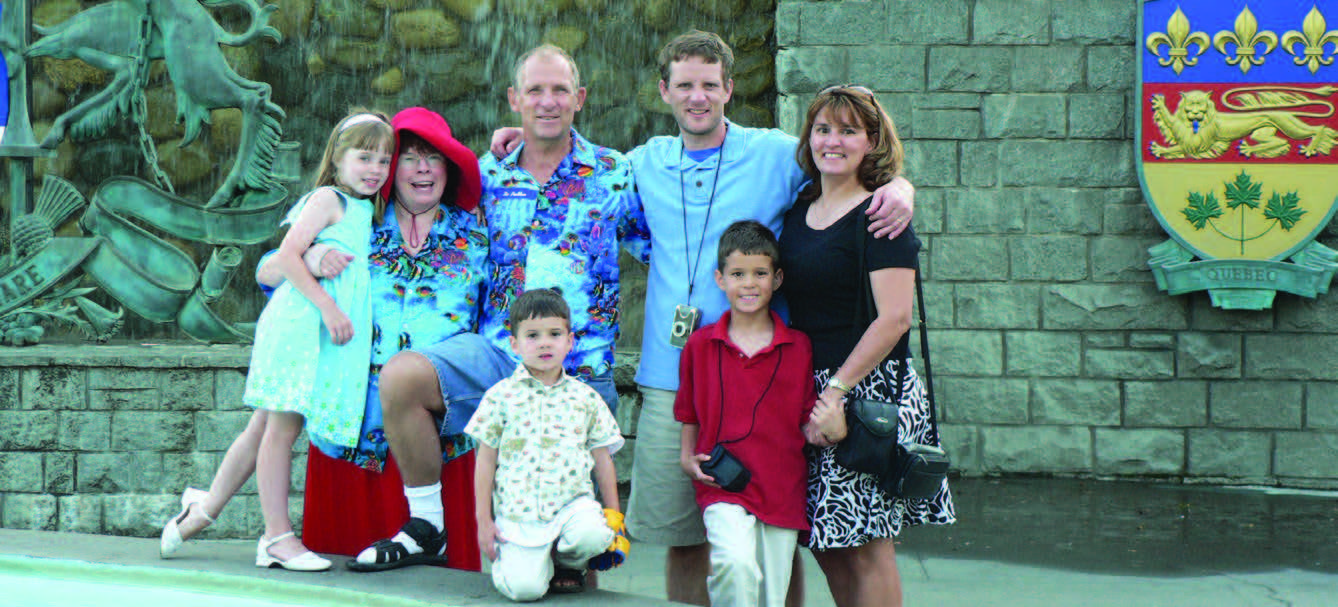
Formative Experiences
Living the life of an outdoorsman had a lot to do with forming the man who is Curtis Hay. But there was a bit more to it than that. Besides spending time exploring the Rocky Mountains, he learned about teamwork by playing a lot of baseball. “I played second base and outfield. My seventh grade team won the Boise city championship. I was proud to be part of a team that achieved success by working together,” he said.
Another very key formative experience for Hay was the year he spent abroad as a high school student. “I spent a full school year as an exchange student in Koblenz, Germany,” he stated. Clearly his sense of adventure extended beyond the American west, even as an adolescent. “I learned to speak passable German and really enjoyed living in a different culture and making new friends. A highlight for me was a two-week ski vacation in Austria and Switzerland during spring break.” It was a big deal for a high school student. The inspiration for his grand European adventure, it turns out, came from another important family member: “My older brother was an exchange student for a year in South Africa. I admired his sense of adventure and how he taught himself to speak Afrikaans.”
After distinguishing himself in high school, Hay went on to attend Seattle Pacific University in Washington state. “My dad and step-mother encouraged me to pursue studies that I found personally fulfilling. I was expected to work hard and to put myself through college on my own. I was fortunate to earn an Air Force ROTC scholarship, which gave me an opportunity to leave Idaho and move to Seattle, to study electrical engineering.”
The scholarship covered most of Hay’s tuition and living expenses, and he worked summer jobs and internships. “Since my parents were never in the military themselves, they were a bit surprised when I chose to join the Air Force, but it set me on a career path that I continue to find tremendously fulfilling.”
Hay graduated from Seattle Pacific on schedule, Class of 1992, and was commissioned as a second lieutenant at the University of Washington. He credits his mother with giving him the fortitude to get through his difficult engineering degree. “She was supportive throughout,” he said, “and she was the one who pinned on my gold bars at my ROTC graduate ceremony at UW.”
Hay was commissioned as a second lieutenant in the U.S. Air Force immediately after graduating. He worked for six months in Dublin, Ireland, for Intel Corporation, while awaiting his first Air Force assignment. That came in 1993 when he was assigned to Air Force Space Command in Colorado Springs, at the foot of the Colorado Rockies. And that was when he first began working with GNSS.
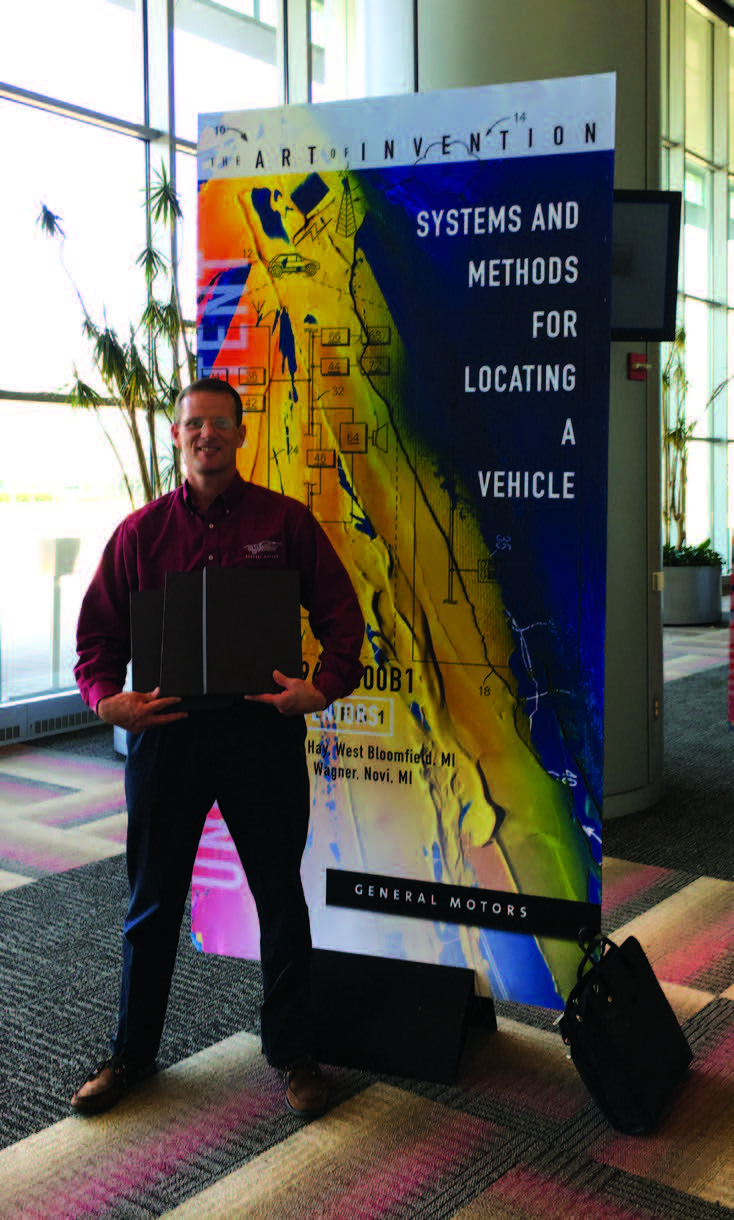
Confirmed GPS-man
“One of my interesting responsibilities at the then-new Air Force Space Command installation in Colorado Springs, now known as Schriever AFB, involved GPS launch and early orbit planning,” Hay said. “That assignment taught me a lot about the series of maneuvers GPS satellites go through between booster separation and achieving their final orbits. The Air Force had just begun launching Block IIR satellites at that time and I had much to learn about the new payload, and how to prepare these new satellites for their mission.”
Hay worked closely with outstanding engineers from Lockheed Martin, and even walked through a Boeing booster while it was being built in Pueblo, Colorado, before it was shipped to Cape Canaveral. “The coordination between military leadership, government officials and civilian contractors to keep the GPS constellation healthy and replenished is highly complex and very professionally managed,” he said. “A highlight for me at that stage of my life was witnessing a live satellite launch at midnight just a mile from the rocket pad. I was hooked. I knew at that time I wanted to make a career out of GPS.”
Hold Everything!
Things took an unexpected though not unpleasant turn for Hay when he laid eyes on someone who would change his life forever. “Christy was living in my neighborhood when I was in Colorado Springs. As I was driving by after work one day I saw her getting the mail in front of her house. I thought she was the most beautiful girl I’d ever seen. Mutual friends invited us both to a Thanksgiving dinner and we began dating,” he recalled.
Hay had a lot to be thankful for. Love chimed in during a memorable autumn hike at the base of the famous Pikes Peak near Colorado Springs–leave it to the Rockies. Hay asked Christy to marry him and she said yes. “In April 1995, my father officiated our wedding as a judge at a historic 1880’s manor in Manitou Springs,” Hay said. “We planned an outdoor wedding and it snowed eight inches the night before.” Leave it to the Rockies, indeed. “We still reminisce about bridesmaids wearing boots in the snow for photos,” he said.
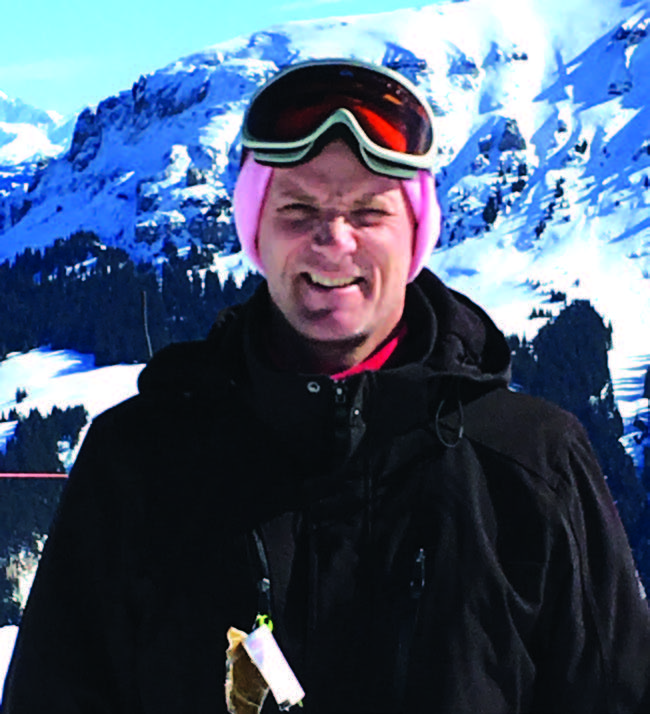
Onward and Upward
After his stint at Space Command and with a new favorite family member at his side, Hay took his second Air Force assignment, this time in Florida at the Air Force Research Laboratory. There he learned how to protect GPS-guided weapons from jamming. “I recall a specific test on the Eglin AFB flight range,” he said, “where my colleagues and I set up high-power jammers on a metal tower in the middle of the night, while our test plane, an F-16 fighter jet, flew directly overhead at 40,000 feet. The GPS-guided, 2,000-pound weapon below the wing was released and precisely hit the down-range target after a 10-mile flight, despite heavy jamming from the ground. This experience taught me the importance of careful preparation; you only get one chance to perform those sorts of tests.
“Also at Eglin, I experienced firsthand how GPS can save lives. Military GPS- and INS-guided weapons navigate themselves to targets on the ground with a diameter of about a meter. This new ‘precision-strike’ technology that emerged in the late 1990s revolutionized air campaigns and substantially reduced civilian casualties. When I first dug a GPS-guided weapon out of the soil below a target at the Air Force test range and saw with my own eyes the remarkable accuracy of GPS, I was convinced this technology had the potential to benefit humanity in incredibly positive ways.”
In Hay’s final military assignment, he worked on development projects for the GPS Control Segment as part of the GPS Joint Program Office. He led a project to include GPS satellite observations from the National Geospatial-Intelligence Agency within the Air Force GPS control network. “That experience gave me a great appreciation for the value of better clock and orbit predictions to improve accuracy for GPS users around the world. And once again I was humbled and proud to serve alongside excellent military officers and very talented civilian engineers.”
Hay left the Air Force in 2001. From then on he would continue his rise as a GNSS man in the civilian world. He started out at General Motors OnStar, developing GPS and INS guidance systems for vehicle navigation, from 2001 to 2004. From 2004 to 2006, he worked for Spirent Federal Systems, the GPS simulator equipment company, where he taught government, military and civilian customers how to perform GPS testing with signal generators.
Then, from 2006 to 2010, at John Deere, Hay led a team developing a highly precise, “next-generation” GNSS receiver for agriculture and construction equipment. “I was amazed at the incredible accuracy available to farmers at costs much lower than for the military,” he said. “I still remember the first time I received a phone call from a farmer who was upset that his new RTK system only delivered four-centimeter accuracy. Our team eventually fixed the problem, but that showed me how better accuracy in agriculture leads to higher profits. When GNSS with RTK can position a machine to place soybean or corn seeds directly over a narrow line of invisible fertilizer, the summer crops will grow better and the fall harvest will be richer.”

Current Occupation
In 2010, Hay joined his current company, General Motors. It was here that he led development of GM’s 4G LTE equipment installed in North American, European and Chinese vehicles. He has also led development of GM’s “Precise GNSS” capability for its automated “Super Cruise” vehicles in North America and China. “Super Cruise is currently on our Cadillac CT6 sedan and is being expanded into other vehicles,” he explained. “It allows our customers to safely take their hands off the wheel and their feet off the pedals on highways that have been precisely mapped with RTK and LiDAR. The first time I experienced Super Cruise as a driver I was amazed at the precision of the lane-centering function.
“Developing that capability required so many different kinds of engineering talent–controls systems engineers, navigation engineers, INS experts, camera experts, and many others. As we continue to develop new and innovative products, I’m continuing to see limitless potential for GNSS to improve vehicle safety, achieve improved levels of automation, save fuel, and reduce traffic congestion. The sky is the limit with the application of GNSS concepts to solve real problems.”
Hay currently also leads GM development of V2X (“vehicle-to-everything” connectivity) equipment for future vehicles.
Hay was recently part of a panel at the Munich Satellite Navigation Summit focused on precise GNSS for automated vehicles. “My colleagues and I communicated a similar message,” he said. “GNSS will continue to provide a critical function for advanced vehicles of the future. There are two fundamental requirements for GNSS/INS systems for these types of applications: First, higher accuracy and, second, high integrity. The first item enables use cases such as automatic lane changes and complex maneuvers at intersections. The second is equally important and notifies the vehicle controller when GNSS/INS inputs are less trustworthy.
“GM is fortunate to have strong partners for precise positioning. We use the excellent Trimble RTX service for GNSS corrections to achieve more accurate positioning and for integrity monitoring. We also use high-definition maps from USHR, a wonderful partner based in California.”
No Place Like Home
Perhaps one of Hay’s greatest feats has been in following his father’s example when it comes to leaving work at the office. A military man, a man of the West, a man of science, a man of industry, ultimately Hay still belongs, first and foremost, to his family. And so we too will follow Hay senior’s example, leaving work behind to return home.
“My wife Christy means the world to me,” Hay said. “We celebrated our 24th wedding anniversary this past April. We’ve shared three military assignments and have moved more times than we can count. We’ve raised three children who are all now in college.”
“Christy works as a substitute teacher and she is wise and understanding. She’s a wonderful mother, has made invaluable contributions toward raising our family, and inspires me to do my best each day. She continues to be my best friend and confidante.”
The Hays’ oldest son, Cameron, 22, is studying environmental science at Northern Michigan University. Like his parents, he loves the outdoors and is planning to become a park ranger. The Hays also have a daughter, Catherine, 20, studying biochemistry at the University of Michigan. “She works as a cancer researcher in the university lab and is a licensed emergency medical technician and will be doing ambulance work this summer,” Hay said. Hay’s youngest son, Curtis Jr., 18, just finished his freshman year at Western Michigan University, where he is studying business and political science.
Hay admits combining a career with parenthood has been difficult. “I worked many long days and weekends to keep up with activities at work,” he said, “but I managed to attend all of my kids’ sports events and theater performances. When those events finished it was right back to work.
“We’ve always prioritized family dinners and connecting with our kids,” Hay said, “and we’ve enjoyed our vacations, including trips to Colorado, Utah, Europe, Puerto Rico, Toronto, Montreal and Maine.”
“My wife has been a great source of strength,” Hay said, “managing our family calendar and the kids’ activities. Whatever career success I’ve found has been enabled by her excellent organizational abilities.”
Still Close
Hay has three half-brothers, two on his father’s side and one on his mother’s. Of his older full-brother, Brandin, whom Hay describes as a gifted student and a life-long learner, he said, “We were very close growing up and continue to stay in regular contact despite our geographic separation.” Together, Hay and his brothers form quite a crew, with some outstanding characters. “My brothers and I sometimes reminisce about our difficult experiences as kids and how we’ve grown into happy and successful professionals.”
Hay’s mother lives and practices law in Salt Lake City. “We stay in regular contact and she continues to inspire me with her community activism and deep sense of responsibility to speak up for those who are disadvantaged,” he said.
“My father is retired and lives near Boise, Idaho, and takes care of my step-mother, who suffers from Parkinson’s disease. Over the years my dad and I met regularly in Colorado during the summer months to climb mountains. His principles and values have inspired and motivated me for my entire life. His example continues to challenge me today, over thirty years after I left home to go to college. Last summer, my 17-year-old son and I went to visit him. We drove through the mountains and rafted the Boise River together.”
And what does Curtis Hay do in his rare “idle time”?
“I enjoy reading about GNSS innovations in Inside GNSS while at home,” he said. [Was that a wink?]
[Thanks, Curtis!]
Today, Hay lives in Washington, Michigan, near the GM facility where he works, just north of Detroit by Lake St. Claire, and while the local environs may not qualify as the great American West, he still manages to get outside for rollerblading and eight-mile treks on weekends.
“I still love hiking and the great outdoors,” he said. And what a backdrop those spaces do make. An amazing setting for an admirable life and career. Westward Ho, Curtis Hay!
